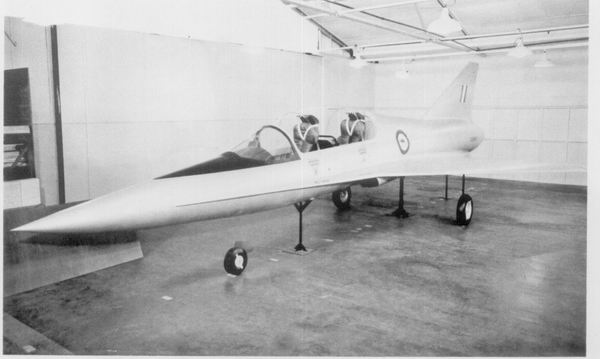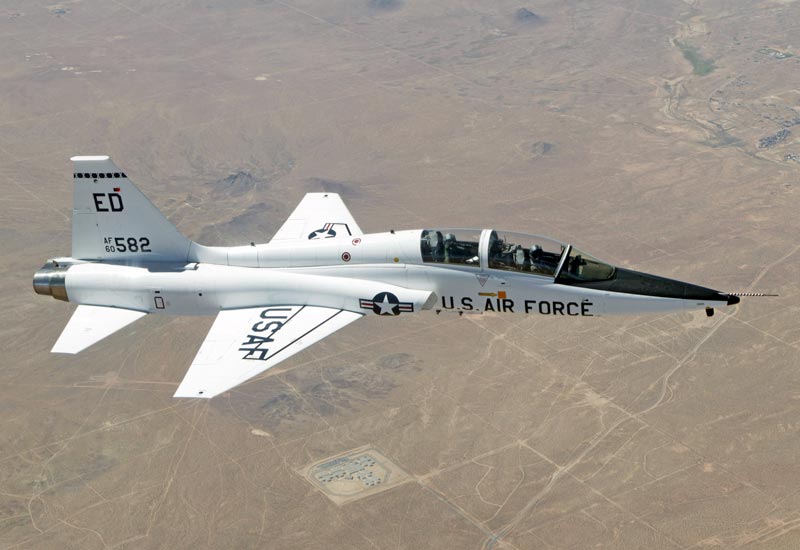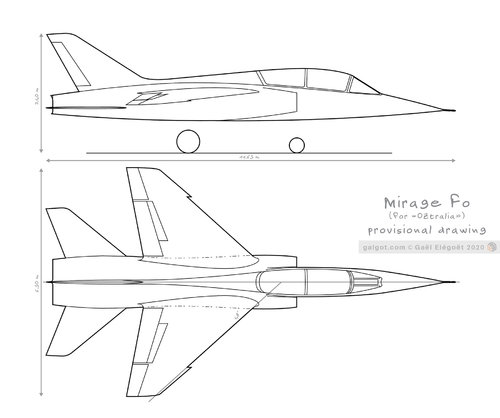Is anyone able to provide some details on this:

You are using an out of date browser. It may not display this or other websites correctly.
You should upgrade or use an alternative browser.
You should upgrade or use an alternative browser.
Mirage F-O Supersonic Trainer for Australia
- Thread starter GTX
- Start date
- Joined
- 21 May 2006
- Messages
- 3,002
- Reaction score
- 2,283
Nice find GTXIs anyone able to provide some details on this:

Unfortunately, I've got nothing to contribute, except that it is also the first time I've seen this picture, let alone know anything about the design.
Regards
Pioneer
Deltafan
ACCESS: Top Secret
- Joined
- 8 May 2006
- Messages
- 1,697
- Reaction score
- 2,318
Is anyone able to provide some details on this:

Mirage F-O (for Australia = Ostralia)Yeeeees ! I saw this one in Liébert book. It was a supersonic trainer by Dassault. If anybody can get a glance inside Liébert book - I'm quite sure it is inside.
-study from second trimester 1967 (1/1 mock-up of the photo certainly later)
-precise role unknown, maybe a "strike trainer"
-Derivative of Mirage F2
-2xGE J85-13 with 1230/1830 kgp
-Length : 11.65 m
-wingspan : 6.50 m
-height : 3.40 m
-wing surface : 14 m²
-wing degrees : 48°
-empty weight : 3400 kg
-max weight : 7200 kg
-max speed sea level : M 0.98
-max speed : M 1.55 at 38 000 ft
That would make it... a Taon ( = a big fly / gnat), which was the name of an earlier Breguet aircraft.A bigger Gnat.
- Joined
- 22 April 2012
- Messages
- 2,258
- Reaction score
- 2,315
This feels like it was aiming at the same Australian requirement for a supersonic lead-in fighter trainer as the CAC CA-31 and CAC/BAC AA-107. The performance figures (Mach 1.55 at altitude) and the timeframe (1967) match and Dassault certainly would have known about the requirement due to their ongoing involvement in the delivery of, GAF/CAC license built, Mirage IIIs to the RAAF. The choice of the J85 matches too as this was the engine initially considered for the CAC CA-31.
yep I thought about these two projects. What you say make tons of sense.
Incidentally, all three projects looked very sexy. Somebody needs to model them and put them side by side on a shelf. (before that happens, I managed to get all three side-by-side in my answer. Groovy, baby !)


Note that we have a delta, a VG, and a swept-wing. Of the three, swept wing is the one that makes the more sense.
(And funnily enough, in the end the RAAF got straight-wing Aermacchi for the job...)
Incidentally, all three projects looked very sexy. Somebody needs to model them and put them side by side on a shelf. (before that happens, I managed to get all three side-by-side in my answer. Groovy, baby !)


Note that we have a delta, a VG, and a swept-wing. Of the three, swept wing is the one that makes the more sense.
(And funnily enough, in the end the RAAF got straight-wing Aermacchi for the job...)
Last edited:
This feels like it was aiming at the same Australian requirement for a supersonic lead-in fighter trainer as the CAC CA-31 and CAC/BAC AA-107. The performance figures (Mach 1.55 at altitude) and the timeframe (1967) match and Dassault certainly would have known about the requirement due to their ongoing involvement in the delivery of, GAF/CAC license built, Mirage IIIs to the RAAF. The choice of the J85 matches too as this was the engine initially considered for the CAC CA-31.
Agreed.
Note that we have a delta, a VG, and a swept-wing. Of the three, swept wing is the one that makes the more sense.
(And funnily enough, in the end the RAAF got straight-wing Aermacchi for the job...)
Yes...sigh
Funny btw, that picture is apparently at the exact same spot as the earlier Dassault ECAT proposal Cavalier mockup:

- Joined
- 25 January 2020
- Messages
- 1,279
- Reaction score
- 1,954
Is anyone able to provide some details on this:
I believe that there is a summary in French Secret Projects 1.
Funny btw, that picture is apparently at the exact same spot as the earlier Dassault ECAT proposal Cavalier mockup:

Most Dassault prototypes and mockups probably were made in the same corner of Saint Cloud plant / hangar / whatever. Dassault is not a very big company...
- Joined
- 27 September 2006
- Messages
- 6,418
- Reaction score
- 6,824
These supersonic trainers were all (as was the BAC P45 and Jaguar T2 cycle for the RAF) trying to compete with the USAF T38 Talon (The West Germans used USAF ones in the States as well). It soon became clear that Hawks and Alpha Jets (a bit slicker than the Aermacchi) were the way to go

 en.m.wikipedia.org
en.m.wikipedia.org

Northrop T-38 Talon - Wikipedia
- Joined
- 21 May 2006
- Messages
- 3,002
- Reaction score
- 2,283
And yet ironically the Northrop T-38 Talon would have sufficed the RAAF requirement for a supersonic lead-in fighter trainer....,perhaps with the exception of the CA-31 design, as one would think it would have afforded the RAAF very similar flying charictoristics of it's Mirage IIIO....
Regards
Pioneer
Regards
Pioneer
Last edited:
- Joined
- 27 September 2006
- Messages
- 6,418
- Reaction score
- 6,824
Guess the RAF and the US Navy won out with the RAAF
 www.airforce.gov.au
Strange how the stuff from the 60s looks more 21c than what we actually have.
www.airforce.gov.au
Strange how the stuff from the 60s looks more 21c than what we actually have.
Hawk 127 | Royal Australian Air Force
The Hawk 127 lead-in fighter prepares qualified Air Force pilots for operational conversion to F/A-18A and F/A-18B Hornets and F/A-18F Super Hornets.
royabulgaf
ACCESS: Top Secret
- Joined
- 29 December 2008
- Messages
- 678
- Reaction score
- 350
Does anyone have a source for three views of the Mirage F.0 and the CA 107?Guess the RAF and the US Navy won out with the RAAF
Strange how the stuff from the 60s looks more 21c than what we actually have.Hawk 127 | Royal Australian Air Force
The Hawk 127 lead-in fighter prepares qualified Air Force pilots for operational conversion to F/A-18A and F/A-18B Hornets and F/A-18F Super Hornets.www.airforce.gov.au
- Joined
- 6 September 2006
- Messages
- 4,838
- Reaction score
- 9,481
There is a rather unique set of links of these Australian trainers with Britain and Italy, but not in the way we might think.
Just a little teaser but the story will be included in a book I am currently working on.
What actually stands out is how the supersonic trainer was an outlier in terms of requirements. The RAAF was lukewarm about how many they wanted, for just a couple of dozen of airframes there was no economic sense behind the idea and trying to get other nations to buy into the idea was hard. Jaguar was the main competitor, pretty quickly even the RAF realised the costs were too high and rowed back on Jaguar trainers, thankfully it made a suitable Hunter replacement otherwise it might have been another embarrassing collaborative failure.
Just a little teaser but the story will be included in a book I am currently working on.
What actually stands out is how the supersonic trainer was an outlier in terms of requirements. The RAAF was lukewarm about how many they wanted, for just a couple of dozen of airframes there was no economic sense behind the idea and trying to get other nations to buy into the idea was hard. Jaguar was the main competitor, pretty quickly even the RAF realised the costs were too high and rowed back on Jaguar trainers, thankfully it made a suitable Hunter replacement otherwise it might have been another embarrassing collaborative failure.
This photo was posted recently on a Facebook group associated with adf-serials.com, and an admin reached out to Dassault Aviation who responded. The admin then posted the following in the thread:
Not a bad answer in these current times, across countries, languages and on an aircraft from 50+yrs ago.
The Mirage Fo, ("o", is the French vowel sound used to represent the sound at the beginning of, "australien"), is a synthesis of the different studies of the ECAT programme, which developed into the Jaguar, and the Mirage F2, without delta and with the canopy of the latter, and tends, by its dimensions, to return to the origins of the French national programme, before the inflation of weight caused by Franco-British cooperation. Two engines were studied during the second quarter of 1967, one using a single Rolls-Royce RB172, given for 3,600 kgp of thrust. Its wing has a leading edge sweep of 48°, with Crusader slats, flaps, ailerons and spoilers with a length of 11.20 m and a wingspan of 6.60 m. It has an MVE of 2,900 kg and carries 2,000 litres of fuel. The pendulum-type landing gear has only one wheel per leg and retracts into the fuselage, forward. The air inlets are semi-circular with no intake ramps. The aircraft can carry a 30 mm gun in a pod under the fuselage and various loads under a wing point: the take-off weight with gun is 4,650 kg and it is quite supersonic.
The other engine is based on two GE J85 engines and was the subject of a presentation model in Australian colours.
The presentation leaflet describes the aircraft as follows:
- Formula directly derived from that of the Mirage Ill F2 which flies successfully, for a supersonic training and ground support aircraft, small, inexpensive with proven engines; the performance is superior to that of the F5 despite its smaller size and 13% less wing area, thanks to elaborate manufacturing processes demonstrated on the F2; the developments envisaged on the J85 suggest a rapid increase from M 1.5 to M 2.
- General characteristics :
- 2 GE J85-13 reactors of 1230/1850 kgp static thrust pg/pgpc,
- length: 11.65 m,
- wingspan: 6.50 m,
- Height under load: 3.40 m,
The Mirage Fo with RB172 engine of January 1968.
- Reference wing area: 14 m²,
- Arrow at the leading edge of the canopy: 48°,
- canopy lengthening: 3,
- Relative wing thickness: 4,5 %,
- MVE: 3,400 kg,
- take-off weight, with a full tank (2100 l): 5 200 kg,
- maximum permissible mass: 7 200 kg,
- Maximum Mach at sea level: M 0.98 and at 38000 ft: M 1.55,
- ceiling: 50,000 ft,
- Autonomy on school missions with two additional tanks at M 0.6 and 30,000 ft: 2.6 h. In supersonic, smooth regime, range of action of 550 km with 4.6 min at M 1.5 and 36000 ft, - in support mission, with two 400 kg bombs or one gun pod or one 600 l tank under fuselage and with, under each wing point, one 400 kg bomb or one 600 l tank, range of action at low altitude and M 0.6 from 230 to 450 km depending on the mission.
The plane has a geometry very similar to that of the Adour engine version but this time the landing gear retracts aft, on the underside of the fuselage. 20% lighter than the ECAT aircraft, the Fo does not envisage the carrying of gears and the SNA is rather rudimentary, close to what was proposed at the origin of the program, without radar. The return to a larger wing is the consequence of the F2's observed good performance in the low speed range, and promises high speeds, but the aircraft would then have required variable section air inlets, which is not in the direction of simplicity or economy.
The Dassault representative that responded did not know the Australian reaction to this proposal, which must have been serious enough for Dassault to incur the cost of manufacturing a model; what need does this aircraft meet, when in hindsight, no purchase in this range of aircraft was made at that time by Australia?
It should be noted that, at the same time and until the end of 1968, the LAC was in negotiations with the Commonwealth Aircraft Company (CAC) for the definition and construction of a strike trainer in the spirit of the Jaguar, and that, as with Dassault, the latest studies would involve a variable geometry aircraft.
The connections with the CAC AA-107 become obvious.
Great thanks to Dassault Aviation for their wonderful response. We'll now be able to add an entry to the website on our what-if page.
Not a bad answer in these current times, across countries, languages and on an aircraft from 50+yrs ago.
Tried a drawing of the J85 version from the picture and the text above :

Two views only, cause I'm lazy.
Only the "- Arrow at the leading edge of the canopy: 48°" in the text doesn't fit well with the pict. It's more 57° as far as I can tell.
Wing really is a scaled down Mirage F1 wing. Control surfaces and tailplane geometry are guess but inspired by F1 too.
Cute bird.
(EDIT: corrected as per overscan remark, with F2 wing)

Two views only, cause I'm lazy.
Only the "- Arrow at the leading edge of the canopy: 48°" in the text doesn't fit well with the pict. It's more 57° as far as I can tell.
Cute bird.
(EDIT: corrected as per overscan remark, with F2 wing)
Last edited:
- Joined
- 27 December 2005
- Messages
- 17,753
- Reaction score
- 26,464
Its technically a scaled-down Mirage III F2 (the big version preceding the F1) wing, with the outboard dogtooth.
Indeed... thanks , missed that these would be F2 like wings. Corrected that. And changed the tailplane geometry to something more F2 too.Its technically a scaled-down Mirage III F2 (the big version preceding the F1) wing, with the outboard dogtooth.
Similar threads
-
Dassault MD.450 Ouragan, Prototypes, Projects & Variants
- Started by Rafix200
- Replies: 28
-
RAAF Wedgetail AEW&C proposals and early designs
- Started by Triton
- Replies: 1
-
-
-
